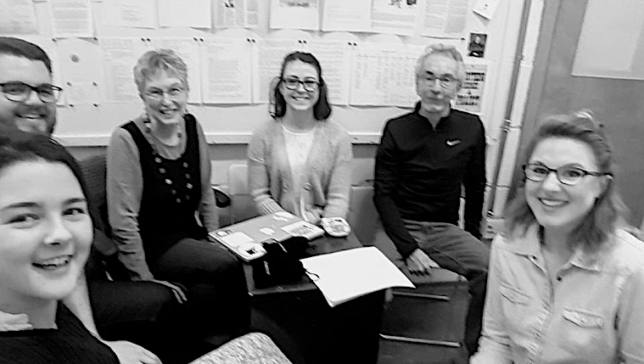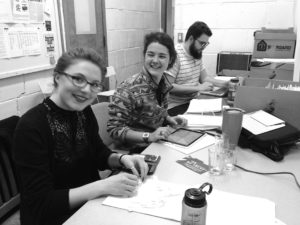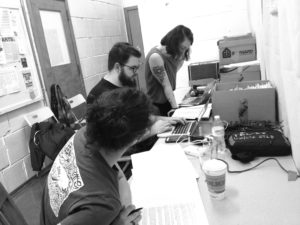Imagine it is 1989
The internet is barely known, email is a strange and difficult idea, and the World Wide Web hasn’t been invented yet. But the censorship wars are raging, the AIDS crisis is hitting artists hard, and debates about public support of the arts in Congress and elsewhere are fiery. Artists and others in the arts need to connect as a community across distances. Arts Wire was created to meet that challenge and is now being rediscovered.

What was Arts Wire?
In early 1989, I puzzled over how to spread the news and make the connections that artists needed. I soon learned about the “information superhighway” and found mentors in San Francisco and Washington DC. Named Arts Wire later that year, the network was built by a small group of us spread from coast to coast—Seattle, Ann Arbor, the Bay area, New York, Arizona, Minnesota, Massachusetts, Pennsylvania, Ohio, Illinois, and more. The New York Foundation for the Arts was its first supporter and its home base throughout. It got started through paper memos, telephone calls, occasional face-to-face meetings and went online on CompuServe, Sprintnet, and finally the internet. We made our own place online with help from a network provider in Arlington (VA) and later moved to Carnegie Mellon.
Arts Wire proselytized on behalf of this new tool, and its staff educated and trained new folks to use the then-baffling technology. The news on Arts Wire came from its staff, steering committee, and individual users—artists, arts funders, and staff of arts organizations, public arts agencies, arts service organizations, and arts advocacy groups. Arts Wire enticed associations to join and bring their members online—National Association of Artists Organizations, National Campaign for Freedom of Expression, Native Arts Network, CraftNet, VisualAIDS, Association of Hispanic Arts, National Assembly of State Arts Agencies, American Music Center, NewMusNet (led by composer Pauline Oliveros), and many more.
Despite the ethic of the day—Don’t use paper! Save it on floppies!—I just couldn’t give up my attachment to words on paper. While trying to be frugal, I nevertheless printed out many “online captures” of what we were doing. As we’ve learned 25 years later, ink on paper is much more stable than the magnetic coating on floppy disks…rusty paper clips aside.
AND_NOW? Archaic Social Media
In 2016, Arts Wire came back into my life as I figured out what to do with my new role as Alum in Residence at the University of Washington’s School of Art + Art History + Design. For one, I thought, why not clear out my storage unit? It was stuffed with banker boxes of materials from a life of “projects.” Interns and I could inventory, discuss, and find a home for them.
Two undergrads signed up for fall quarter, two more joined us in the winter, for a total of two art students and two art history students. Arts Wire would be a good, discrete project to start with. All four interns—Karen Beech, Jessica Capó, Zach Heinemeyer, and Lizzie Trelawny-Vernon—have taken the project on with intelligence, imagination, and overflowing enthusiasm.
As the intern team digs into the 16 banker boxes of my print-outs and other materials, they’re creating an inventory and engaging in conversations with me and with special guests about what they’re finding. They’re learning about archiving, but also about how a new entity can be created and what the early days of the technology were like (before they were born). They’ve found things that make them laugh out loud and things that are completely puzzling. As importantly, they find sobering news of events going on in Arts Wire’s times and discover how related the news is to the news of our world today—censorship, health crises, discrimination, political battles, protests, media debates, and the impact of the latest technologies. They’ve mentioned gaining a new understanding of history with the advantage that they can talk with people who were there and are still alive now (many, even, still kicking!).

Toward the end of February 2017, they produced and presented a series of public programs to start sharing what they learned. The series, named “AND_NOW?” after the opening prompt on Arts Wire’s first home page, included:
- A week-long take-over of the art school’s Instagram account – #AND_NOW?
- An exhibition, “AND_NOW? Archaic Social Media,” that drew on material from Arts Wire files and ran from February 23 to March 10 at Parnassus, the school’s storied coffee shop
- A podcast series, “AND NOW? Archaic Social Media” <andnowpodcast.wordpress.com>, launched on February 24 that includes interviews with people involved in Arts Wire as well as wide-ranging conversations that investigate, through today’s eyes, ideas found in Arts Wire files.
My files only go from early 1989 through about 1995 when I bowed out. Other people, in other parts of the country, can continue the story, post-1995. One person who has written much of this history is Judy Malloy, an early social media poet and arts writer, and an important Arts Wire staff member. Recently she wrote a chapter about Arts Wire for a book she edited, Social Media Archeology and Poetics, published last year.1 One of my favorite quotes from that chapter comes from Kenny Greenberg, who, in a 1994 review of Arts Wire for Internet World, observed:
As with art—Gophers, SIGs, and HTTP sites notwithstanding—it is the human spirit that makes Arts Wire special. The voices behind the information and the personal reactions to the data make Arts Wire a lively place.
![]()
1 Social Media Archeology and Poetics, edited by Judy Malloy, published by The MIT Press, 2016.
This work is possible because of support from the Jini Dellaccio Project.
![]()


Yessiree, we coopted our phone lines to fire up our 1200 baud modems and barrage each other with chunks of ASCII text significantly longer than 140 characters, and we liked it. (-;
Sounds like a great project. It’d be interesting to learn more about what grew out of Arts Wire.
Thanks for the memories, Steve!
One thing I remember about those modems is trying to connect from a hotel room. It often meant moving the bed to find the phone jack and then figuring out how many commas to add to the address to get past the hotel’s switchboard.
You also inspired me to estimate the number of characters in the 1992 Arts Wire banner at the top of this post. It’s about 315, quite a few more than a tweet today!
Thanks to Judy, I just found this post. Thanks, Anne, for being a hoarder, I mean an archivist! 😉 In the late ‘80s, I started an organization called ArtFBI (Artists for a Better Image) to study stereotypes of artists in contemporary culture. I also was on the board of Arts Wire.
While I had access to the net in the early ‘90s, I knew local artists in the Baltimore/DC area were not connected. So, I produced a monthly faxazine of art news and information. I still have all the issues. You can see ArtFBI’s web page at https://outtacontext.com/projects/artfbi
What a treat to find a comment from you, Jeff! Of course I remember ArtFBI and the role you played at Arts Wire. We didn’t have websites back then, in fact, almost nobody did. Before the web showed up, I wanted artists to be the ones who created a graphic user interface for everybody (ah, the phantom GUI). Many thanks to Judy for making connections!